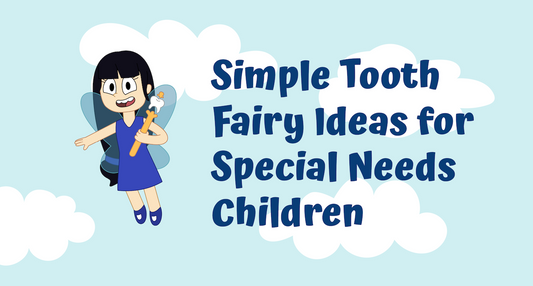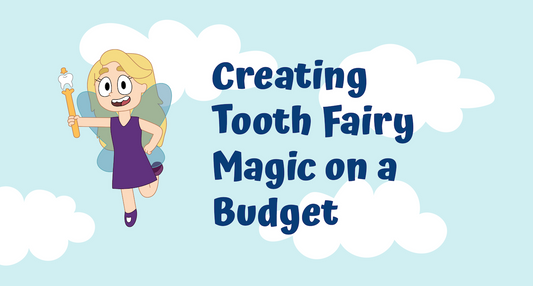While American children place their baby teeth under pillows for the tooth fairy, children around the world participate in fascinating and diverse tooth loss traditions. These cultural practices not only mark an important childhood milestone but also connect children to their heritage and community. Discover how different cultures celebrate lost teeth, from throwing teeth onto roofs to feeding them to animals, and find inspiration to incorporate these global traditions into your family's tooth fairy experience.
Tooth Traditions in the United States
In the United States, children typically place their lost baby teeth under their pillows at night. While sleeping, the tooth fairy – a magical, sprite-like creature – visits to collect the tooth, leaving behind money or small gifts. This tradition dates back to the early 1900s, though the concept of a magical figure associated with lost teeth has much older roots.
What we can learn: The American tooth fairy tradition emphasizes the magical transformation of something no longer needed (a baby tooth) into something of value (money or gifts). This exchange teaches children about life transitions and finding the positive in change.
Tooth Traditions in Spain and Hispanic Countries
In Spain and many Hispanic countries, children are visited by "El Ratoncito Pérez" (Pérez the Mouse) instead of a tooth fairy. Children place their teeth under their pillows or in small boxes beside their beds, and the tooth mouse exchanges them for gifts or coins during the night. In some regions, children place their teeth in a glass of water, and Ratoncito Pérez drinks the water, takes the tooth, and leaves a gift.
What we can learn: The Ratoncito Pérez tradition demonstrates how different cultures create their own magical beings to help children through this developmental milestone. The variation of placing teeth in water adds an interactive element that children can check in the morning.
Tooth Traditions in Japan
In Japan, children follow a unique directional tradition. Lower jaw teeth are thrown upward toward the roof, while upper jaw teeth are thrown downward (sometimes buried in the dirt). This practice expresses the wish for new teeth to grow in straight and strong, in the direction of the discarded tooth. Some families preserve this tradition by throwing teeth onto the roof of their home.
What we can learn from Japan: The Japanese tradition symbolically connects the direction of the thrown tooth with the desired growth direction of the new tooth. This teaches children about setting intentions for healthy development.
Tooth Traditions in Middle Eastern Countries
In countries like Egypt, Jordan, Iraq, and Sudan, children often throw their teeth toward the sun or sky while reciting wishes for strong replacement teeth. Some children wrap their teeth in cotton or tissue before throwing them, reciting specific phrases asking for their tooth to be exchanged for one from a gazelle – an animal known for its beautiful, strong teeth.
What we can learn: This tradition connects children to celestial elements (sun, sky) while focusing on positive wishes for their dental development. The comparison to gazelle teeth teaches children to aspire to nature's strength and beauty.
Tooth Traditions in Turkey
Turkish children and their families often believe that burying a lost baby tooth in a place of significance can influence the child's future. For example, burying a tooth in a football field might help a child become an athlete, while burying it on university grounds might lead to academic success. The location is chosen based on what parents hope for their child's future.
What we can learn from Turkey: The Turkish tradition directly connects tooth disposal to future aspirations, teaching children about setting goals and working toward specific life paths. This tradition offers wonderful opportunities for family discussions about hopes and dreams.
Tooth Traditions in South Korea
In South Korea, children (or their parents) throw teeth onto the roof of their home, often shouting a wish for a mouse to take the old tooth and bring a new, stronger one. This tradition stems from the belief that mice have strong, continually growing teeth that never fall out – a desirable quality for a child's permanent teeth.
What we can learn: The Korean tradition draws on animal symbolism to teach children about desirable qualities in their own development. The ritualistic shouting adds an emotional release that can help children process this physical change.
Tooth Traditions in India
In many parts of India, children throw their lost teeth onto the roof while asking a sparrow to take their old tooth and bring them a new one. Some regions have children bury their teeth near specific trees or plants associated with strength or longevity. The disposal of the tooth is often accompanied by specific prayers or wishes for healthy new teeth.
What we can learn from India: India's traditions often incorporate elements of nature, connecting children's physical development to the natural world. The inclusion of prayers teaches children about expressing gratitude and hope during transitions.
Tooth Traditions in Scandinavian Countries
Countries like Norway, Sweden, and Denmark have a tradition called "tann-fe" (tooth fee) similar to the American tooth fairy, but with some variations. Children sometimes place their teeth in water glasses rather than under pillows, and the fairy may leave different types of gifts based on regional customs. In Viking times, children's teeth were considered to bring good luck in battle.
What we can learn: Scandinavian traditions show how customs evolve over time while maintaining their core purpose of marking childhood milestones. The historical connection to Viking beliefs demonstrates how deeply rooted these practices are in human history.
Tooth Traditions in China
In China, upper teeth are placed at the foot of the child's bed, and lower teeth are placed on the roof (or thrown there). This practice stems from the belief that this placement will help new teeth grow in the proper direction. Some families also save their children's teeth as keepsakes rather than disposing of them.
What we can learn from China: The Chinese tradition emphasizes directionality similar to Japanese customs, but with the added element of preservation. This balance between letting go and keeping mementos teaches children about honoring growth while preserving memories.
Tooth Traditions in Brazil
In Brazil, children often throw their teeth outside for birds (especially tiny yellow birds). According to tradition, if a bird finds and takes the tooth, a new one will grow in its place. Some Brazilian families have adopted the tooth fairy tradition as well, creating a blend of cultural practices.
What we can learn: Brazil's tradition involving birds brings an element of nature and chance into the tooth loss experience. The cultural blending seen in modern Brazilian families demonstrates how traditions can adapt and combine over time.
Tooth Traditions in France
French children place their teeth under their pillows for "La Petite Souris" (The Little Mouse), who exchanges them for money or small gifts. This mouse character shares similarities with Spain's Ratoncito Pérez but has its own distinct French cultural context and history.
What we can learn from France: The French tradition shows how magical childhood figures often take forms that children can easily imagine and relate to. Small creatures like mice can supposedly access tiny spaces, making them perfect magical visitors for tooth collection.
Bringing Global Traditions Home
These diverse tooth traditions share common themes of:
- Marking an important childhood milestone
- Providing comfort during a potentially confusing physical change
- Creating a special ritual to celebrate growth and development
- Connecting children to cultural heritage and community
Families can incorporate elements from these global traditions into their own tooth fairy practices:
- Create a special tooth box inspired by Hispanic traditions
- Write wishes for strong new teeth like Middle Eastern cultures
- Document the direction of lost teeth like Asian traditions
- Include animal elements in tooth fairy stories like Korean or Brazilian customs
These diverse tooth traditions show that across cultures, losing baby teeth is considered a significant childhood milestone worth celebrating. Whether teeth are thrown on roofs, placed in special boxes, or left for magical creatures, the transition is marked with care and often a touch of magic. At Hi Tooth Fairy, we celebrate this diversity while creating our own special tradition with our six tooth fairy friends from Flutterville. What global traditions might you incorporate into your family's tooth fairy celebrations?




